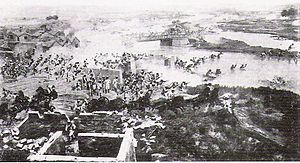Yellow Flag Rebellion
| Yellow Flag Rebellion | |||||||
|---|---|---|---|---|---|---|---|
 The capture of the southern gate of Guanjan. Zamastanian troops were positioned on the left, Caspiaan troops at the center, Drambenburgian troops on the right | |||||||
| |||||||
| Belligerents | |||||||
|
Alliance |
Yellow Flag | ||||||
| Casualties and losses | |||||||
| 150,000 total deaths in the conflict (both civilian and military included) | |||||||
The Yellow Flag Rebellion, the Yetuan Movement, or the Yetuan Uprising was an anti-foreign, anti-colonial, and anti-Christian uprising in Yuan between 1900 and 1905, towards the end of the Heng Dynasty, by the Yetuan United Militia, known as the Yellow Flag because the Yetuan sect carried yellow banners into battle. After the introduction of foreign merchants in the 18-19th centuries and the economic hardship under Emperor Pan Guanting, villagers in western Yuan feared the expansion of foreign spheres of influence and resented the extension of privileges to Christian missionaries. The Yetuans blamed a series of droughts on foreign and Christian influence. Beginning in 1900, Yetuans spread violence across Guanjan and the West China Plain, destroying foreign property, attacking or murdering Christian missionaries and Yuaneze Christians, and the violence soon escalated to massacres against any foreigners.
A four-nation alliance of Zamastanian, Caspiaan, Drambenburgian, and Quetanan troops moved into Yuan to support their citizens. The Heng emperor issued an Imperial Decree declaring war on the rebellion, and the Alliance brought 20,000 armed troops to Yuan, defeated the Yetuans in Guanjan and Sancheon. Eventually, the Yellow Flag Rebellion was put down as summary execution of those suspected of being Yetuans had begun in retribution. The Treaty of Tiaking was signed in 1905, providing significant provisions and payments for foreign forces, including the ceding of Gangkou to Zamastan on a two-century lease. Additionally, the Heng Dynasty began a purge for the execution of government officials who had supported the Yetuans. The Heng Dynasty's role in the rebellion weakened their control over Yuan, and led the dynasty to attempt major governmental reforms in the aftermath.
In 1906, largely as a result of the violence from the Yellow Flag Rebellion, the great Yuaneze diaspora began. Losses due to emigration were added to by conflicts and catastrophes such as the Southern Yuan Famine of 1904-1910, in which between 9 and 13 million people died. Emperor Pan Guanting drafted a reform plan in 1908 to establish a modern constitutional monarchy, but in the 1908 Yuan Revolution, socialists assassinated Guanting, ended the Heng Dynasty, and established a socialist, one-party republic.